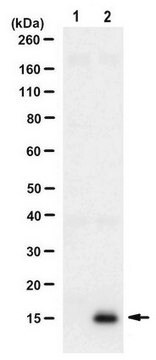MABE1126
Anti-DNA G-quadruplex (G4) Antibody, clone 1H6
clone 1H6, from mouse
Synonim(y):
DNA G-quadruplex (G4)
About This Item
Polecane produkty
pochodzenie biologiczne
mouse
Poziom jakości
forma przeciwciała
purified immunoglobulin
rodzaj przeciwciała
primary antibodies
klon
1H6, monoclonal
reaktywność gatunkowa (przewidywana na podstawie homologii)
all
metody
ELISA: suitable
flow cytometry: suitable
immunocytochemistry: suitable
immunohistochemistry: suitable (paraffin)
izotyp
IgG2bκ
Warunki transportu
wet ice
docelowa modyfikacja potranslacyjna
unmodified
Powiązane kategorie
Opis ogólny
Specyficzność
Immunogen
Zastosowanie
Immunocytochemistry Analysis: A representative lot detected discrete DNA G-quadruplex (G4) foci on the compact chromosome in the metaphase HeLa and murine embryonic stem cells (Henderson, A., et al. (2014). Nucleic Acids Res. 42(2):860-869).
Immunocytochemistry Analysis: A representative lot detected greatly diminished nuclear DNA G-quadruplex (G4) immunoreactivity upon DNase treatment of paraformaldehyde-fixed and Triton X-100-permeablized HeLa cells (Henderson, A., et al. (2014). Nucleic Acids Res. 42(2):860-869).
Immunocytochemistry Analysis: A representative lot detected G-quadruplex (G4) stabilizing agent telomestatin/TMS treatment-induced nuclear DNA G4 immunoreactivity in chicken DT40 cells lacking the G4-unwinding helicase FANCJ, while the drug enhancing effect was not seen in human FANCJ-expressing DT40 cells (Henderson, A., et al. (2014). Nucleic Acids Res. 42(2):860-869).
Immunocytochemistry Analysis: A representative lot detected a time-dependent increase of nuclear DNA G-quadruplex (G4) foci in U20S cells following the treatment of the DNA G4-stabilizing agent telomestatin/TMS (Henderson, A., et al. (2014). Nucleic Acids Res. 42(2):860-869).
ELISA Analysis: Target selectivity of a representative lot was determined by competitive ELISA. Clone 1H6 binds both tetramolecular and unimolecular (intramolecular) DNA G-quadruplex (G4) structures (Henderson, A., et al. (2014). Nucleic Acids Res. 42(2):860-869).
Flow Cytometry Analysis: A representative lot detected enhanced DNA G-quadruplex (G4) immunoreactivity in HeLa cells upon treatment with the DNA G4-stabilizing agent TMPyP4, Cat. No. 613560 (Henderson, A., et al. (2014). Nucleic Acids Res. 42(2):860-869).
Immunohistochemistry Analysis: A representative lot detected nuclear DNA G-quadruplex (G4) immunoreactivity in various paraffin-embedded human tissue sections, including skin, pancreas, testis, placenta, brain, appendix, colon, and kidney (Henderson, A., et al. (2014). Nucleic Acids Res. 42(2):860-869).
Epigenetics & Nuclear Function
Nuclear Receptors
Jakość
Immunocytochemistry Analysis: 2.0 µg/mL of this antibody detected DNA G-quadruplex (G4) in HeLa cells.
Postać fizyczna
Przechowywanie i stabilność
Inne uwagi
Oświadczenie o zrzeczeniu się odpowiedzialności
Not finding the right product?
Try our Narzędzie selektora produktów.
polecane
Kod klasy składowania
12 - Non Combustible Liquids
Klasa zagrożenia wodnego (WGK)
WGK 1
Temperatura zapłonu (°F)
Not applicable
Temperatura zapłonu (°C)
Not applicable
Certyfikaty analizy (CoA)
Poszukaj Certyfikaty analizy (CoA), wpisując numer partii/serii produktów. Numery serii i partii można znaleźć na etykiecie produktu po słowach „seria” lub „partia”.
Masz już ten produkt?
Dokumenty związane z niedawno zakupionymi produktami zostały zamieszczone w Bibliotece dokumentów.
Nasz zespół naukowców ma doświadczenie we wszystkich obszarach badań, w tym w naukach przyrodniczych, materiałoznawstwie, syntezie chemicznej, chromatografii, analityce i wielu innych dziedzinach.
Skontaktuj się z zespołem ds. pomocy technicznej







